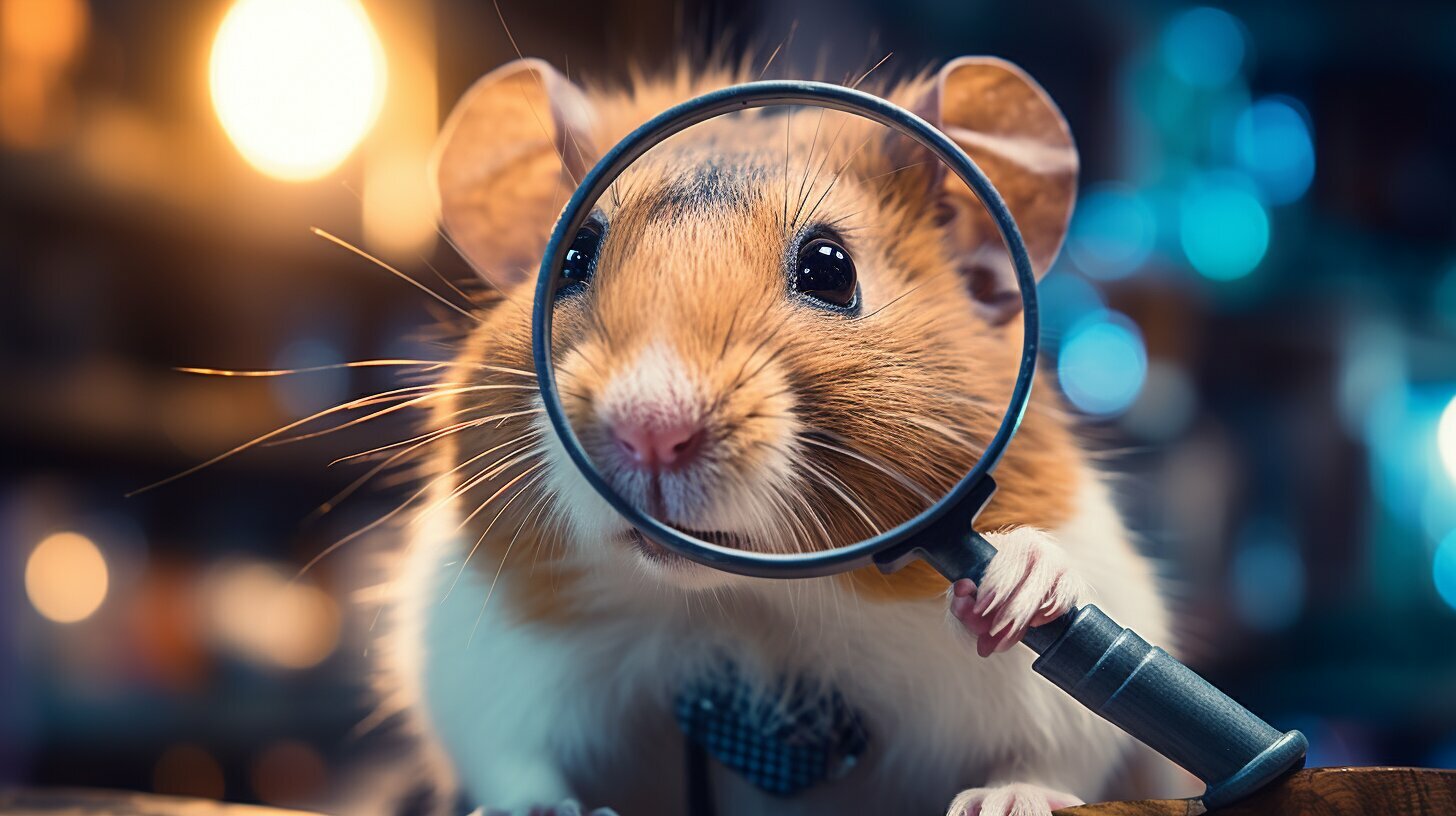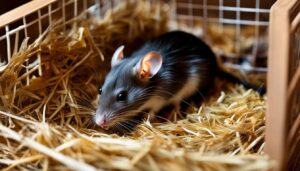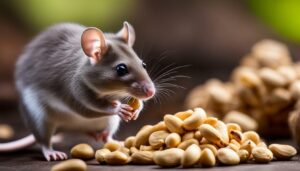If you’ve ever wondered about the quality of your hamster’s eyesight, you’re not alone. Understanding how well hamsters can see is crucial for their overall well-being and care. In this article, we will explore the fascinating world of hamster eyesight, diving into their visual capabilities, limitations, and adaptations. Let’s uncover the mysteries behind hamster vision and gain a deeper appreciation for these adorable little creatures.
Key Takeaways:
- Hamsters have poor eyesight and can only see a few inches in front of them.
- They rely on their hearing and smell to navigate their surroundings.
- In the wild, hamsters live in low-light conditions and are most active during dawn and dusk.
- Hamsters have a strong sense of hearing and smell, which they use to find food, communicate, and mark their territory.
- They have limited color vision and are mostly able to see shades of green.
How Well Can Hamsters See?
Understanding how well hamsters can see requires us to explore their visual capabilities and any associated issues. Hamsters, in general, have very poor eyesight and can only see a few inches in front of them. Their vision is not well-developed, and they rely heavily on their other senses to navigate their surroundings.
In the wild, hamsters live in low-light conditions and are not accustomed to bright light. They are most active during dawn and dusk when there are fewer predators around. This behavior is due to their natural adaptation to their environment and their limited eyesight. Hamsters have a strong sense of hearing and can detect high frequencies that humans cannot. Their sense of smell is also highly developed and they use it to find food, communicate with other hamsters, and mark their territory.
While hamsters are not completely colorblind, they have limited color vision and can mostly see shades of green. They are unable to see well in complete darkness, but they can navigate in low-light conditions using their smell and hearing. It is important to note that hamsters have delicate ears, so it is crucial to keep them away from loud noises that could cause them distress.
Overall, hamsters rely on their senses of hearing and smell to compensate for their poor eyesight and navigate their environment. Their visual limitations are a natural adaptation to their habitat and lifestyle, highlighting the importance of understanding and accommodating their unique needs.
The World of Hamster Vision
The world as seen through a hamster’s eyes is vastly different from our own, as they possess a distinct type of vision found in rodents. Hamsters have very poor eyesight and can only see a few inches in front of them. Their vision is primarily designed for navigation in their natural habitat, which is typically low-light conditions. Bright light can be overwhelming for them, and they are most active during dawn and dusk when there are fewer predators around.
Hamsters rely heavily on their other senses, such as hearing and smell, to navigate their environment. They have a strong sense of hearing and can detect high frequencies that are inaudible to humans. This heightened hearing helps them locate potential threats and communicate with other hamsters through various vocalizations. Additionally, their sense of smell is highly developed, allowing them to find food, recognize familiar scents, and mark their territory.
While hamsters are not completely colorblind, their color vision is limited. They can mostly perceive shades of green, but their ability to see other colors is limited. This is because their eyes contain a different set of photoreceptor cells compared to humans. Additionally, hamsters struggle to see in complete darkness, but they can navigate in low-light conditions using their sense of smell and hearing.
It is important to note that hamsters have fragile ears, so it is crucial to keep them away from loud noises that could cause distress or potential harm. Protecting their ears and providing a quiet environment is essential for their overall well-being.
| Key Points: |
|---|
| Hamsters have poor eyesight and are most active during dawn and dusk in low-light conditions. |
| They rely on their heightened sense of hearing to detect sounds that are inaudible to humans. |
| Hamsters have a highly developed sense of smell, which they use to find food and communicate with other hamsters. |
| Their vision is limited in terms of color perception, and they struggle to see in complete darkness. |
| Hamsters have fragile ears, so it is important to protect them from loud noises that could cause distress. |
Environmental Adaptations
Hamsters have evolved unique environmental adaptations to compensate for their limited eyesight, allowing them to thrive in their natural habitats. These adaptations enable hamsters to navigate their surroundings and ensure their survival in the wild.
One of the key adaptations is their preference for low-light conditions. In the wild, hamsters are most active during dawn and dusk when there are fewer predators around. This allows them to take advantage of the dim lighting to move around and forage for food without being easily spotted. By avoiding bright light, hamsters can minimize their exposure and reduce the risk of predation.
Additionally, hamsters have developed heightened senses of hearing and smell to compensate for their poor eyesight. Their sense of hearing is particularly remarkable, as they can detect high frequencies that are beyond the range of human perception. This acute hearing helps them identify potential threats and also locate sources of food or water.
Hamsters also rely heavily on their sense of smell. With their highly developed olfactory system, hamsters can detect scents from a distance and use them to navigate their environment, find food, communicate with other hamsters, and mark their territory. This heightened sense of smell plays a crucial role in their daily activities and helps them compensate for their visual limitations.
| Environmental Adaptations | Benefits |
|---|---|
| Preference for low-light conditions | Minimizes exposure and reduces risk of predation |
| Heightened sense of hearing | Identifies threats and locates food and water sources |
| Highly developed sense of smell | Navigates environment, finds food, communicates, and marks territory |
These environmental adaptations allow hamsters to successfully navigate their habitats and fulfill their survival needs. By relying on their acute senses of hearing and smell, hamsters are able to compensate for their limited eyesight and thrive in a world that may seem visually challenging to humans.
Limited Color Vision
Unlike humans, who perceive a broad spectrum of colors, hamsters have a more limited color vision. While humans can see a rainbow of hues, hamsters primarily see shades of green. This is due to the distribution of photoreceptor cells in their eyes, which are most sensitive to green light. As a result, their perception of the world is somewhat monochromatic compared to ours.
Hamsters’ limited color vision may not be a disadvantage in their natural habitat. In the wild, hamsters are nocturnal creatures that prefer dimly lit environments. Their vision has adapted to these low-light conditions, allowing them to navigate their surroundings effectively. Hamsters rely on their other senses, such as hearing and smell, to compensate for their visual limitations.
In addition to their limited color vision, hamsters also have difficulty seeing well in complete darkness. However, they can still navigate in low-light conditions using their sense of smell and hearing. Hamsters have an acute sense of smell, which helps them locate food and identify other hamsters. Their hearing is also highly developed, allowing them to detect high frequencies that are beyond the range of human hearing.
| Hamster Vision: | Human Vision: |
|---|---|
| Shades of green | Full spectrum of colors |
| Poor in complete darkness | Adaptable to various lighting conditions |
| Relies on smell and hearing | Relies primarily on visual perception |
| Well adapted to low-light conditions | Well adapted to a wide range of lighting conditions |
In summary, hamsters’ limited color vision, along with their ability to navigate in low-light conditions, helps them survive in their natural habitats. While they may not see the world in the same vibrant way that humans do, hamsters rely on their senses of smell and hearing to compensate for their poor eyesight. Understanding the unique characteristics of hamster vision allows us to appreciate the adaptations that contribute to their survival in the wild.
Navigating in Low-Light Conditions
Hamsters possess unique abilities to navigate in low-light conditions, relying on their exceptional sense of smell and acute hearing. While they have poor eyesight, hamsters have adapted to their environment by utilizing other senses to explore their surroundings.
In the wild, hamsters are crepuscular, meaning they are most active during dawn and dusk when the light is dim. This is because hamsters have evolved to live in burrows where light is scarce, making them well-suited to low-light conditions. Their eyesight is not designed for bright light, so they rely on other senses to locate food, identify predators, and interact with their environment.
| Hamster Senses | Function |
|---|---|
| Hearing | Hamsters have a remarkable sense of hearing, capable of detecting high frequencies that are inaudible to humans. This allows them to perceive sounds in their environment, helping them navigate and avoid potential dangers. |
| Smell | The sense of smell is highly developed in hamsters and plays a crucial role in their navigation. They rely on their sense of smell to locate food, communicate with other hamsters, and mark their territory. Their ability to detect and interpret scents allows them to navigate their surroundings with great precision. |
In addition to their keen sense of smell and hearing, hamsters also possess the ability to utilize their whiskers (vibrissae) as a tactile guide. Vibrissae are highly sensitive and help hamsters determine the proximity and shape of objects, enabling them to navigate tight spaces and avoid obstacles in their path.
Hamster Eyesight in Low-Light
While hamsters can’t see well in complete darkness, they are adapted to see in low-light conditions. Their eyes are highly sensitive to even the faintest glimmers of light, allowing them to make out shapes and objects in dimly lit environments.
Hamsters’ visual acuity is better suited for detecting motion rather than discerning fine details. This adaptation helps them identify potential threats and react quickly in their natural habitat.
Hamsters’ reliance on their senses of smell and hearing, combined with their ability to see in low light, allows them to navigate their environment effectively despite their poor eyesight. It’s a testament to their remarkable adaptability and survival mechanisms.
| Hamster Navigation | Methods |
|---|---|
| Smell | Hamsters use scent trails to find their way around. They leave behind pheromones as markers, allowing them to retrace their steps and find their way back to their burrows. |
| Hearing | Hamsters rely on their acute hearing to detect predators and potential sources of food. They can distinguish sounds and determine their direction, aiding them in navigation and survival. |
Overall, the combination of their sense of smell, acute hearing, and ability to see in low-light conditions allows hamsters to navigate with relative ease, despite their limited eyesight. These remarkable adaptations enable them to thrive in their natural habitat and underscore the fascinating world of hamster vision.
Fragile Ears and Sensitivity to Noise
As hamsters rely heavily on their sense of hearing, it is crucial to understand the fragility of their ears and the potential impact of loud noises. Hamsters have incredibly sensitive ears, capable of detecting high-frequency sounds that are beyond the range of human hearing. Their ears are designed to pick up even the slightest rustle or movement in their environment, alerting them to potential danger.
However, this heightened sense of hearing comes with a downside. Hamster ears are delicate and can be easily damaged by loud noises. Exposure to loud sounds can cause stress and anxiety in hamsters, leading to behavioral changes and a decline in overall well-being. It is important to create a quiet and peaceful environment for your hamster, ensuring that they are protected from loud noises such as loud music, vacuum cleaners, or construction work.
Additionally, it is crucial to be mindful of the type of bedding you use for your hamster. Certain types of bedding, such as wood shavings or straw, can create a noisy environment for your furry friend. Opting for quieter bedding options, such as paper-based bedding or shredded paper, can help minimize noise levels and provide a more comfortable living space for your hamster.
In conclusion, the fragility of hamster ears and their sensitivity to noise should be taken into consideration when caring for these small pets. By providing them with a calm and quiet environment, you can help ensure their overall well-being and enhance their quality of life.
Dawn and Dusk Activity Patterns
Hamsters are most active during dawn and dusk when their limited eyesight is better suited for navigating their surroundings. In the wild, hamsters have adapted to a nocturnal lifestyle, taking advantage of the lower light levels during these times of day. Their eyes, while not well-equipped for bright light, are more effective in low-light conditions.
During dawn and dusk, hamsters emerge from their burrows to forage for food, explore their territory, and engage in social interactions. Their limited eyesight, which allows them to see only a few inches in front of them, is sufficient for these activities in the dim light.
Hamsters rely on their other senses to compensate for their poor eyesight. Their sense of hearing is particularly acute, allowing them to detect high frequencies that humans cannot perceive. They use this heightened sense of hearing to detect the presence of predators and communicate with other hamsters. Their sense of smell is also highly developed, helping them locate food sources and mark their territory.
While hamsters can navigate in low-light conditions, complete darkness poses a challenge. However, they can still rely on their sense of smell and hearing to find their way in the dark. Their whiskers, which are highly sensitive, help them navigate obstacles and sense changes in their environment.
| Key Points |
|---|
| Hamsters are most active during dawn and dusk. |
| They have limited eyesight, but it is sufficient for their nocturnal activities. |
| Hamsters rely on their sense of hearing and smell to compensate for their poor eyesight. |
| They can navigate in low-light conditions using their other senses. |
Comparing Hamster Vision to Humans
Understanding hamster vision becomes clearer when we compare it to our own human visual abilities. While humans have the ability to see a wide spectrum of colors and have sharp visual acuity, hamsters have a much more limited vision. Hamsters have poor eyesight and can only see a few inches in front of them. They rely on their other senses, namely hearing and smell, to navigate their surroundings.
Hamsters have a different visual range compared to humans. In the wild, hamsters live in low-light conditions and are not accustomed to bright light. This is why they are most active during dawn and dusk when there are fewer predators around. Their eyes have adapted to these dim lighting conditions, allowing them to navigate and forage for food.
One fascinating aspect of hamster vision is their heightened hearing abilities. Hamsters have a strong sense of hearing and can detect high frequencies that humans cannot. This allows them to detect potential threats and communicate with other hamsters through vocalizations. Additionally, their sense of smell is highly developed and they rely on it to find food, locate their burrows, and mark their territory.
While hamsters are not completely colorblind, they have limited color vision compared to humans. They can mostly see shades of green and have difficulty distinguishing between other colors. Hamsters are also unable to see well in complete darkness, but they can navigate in low-light conditions using their smell and hearing.
| Hamster Vision | Human Vision |
|---|---|
| Poor eyesight | Sharp visual acuity |
| Adapted to low-light conditions | Accustomed to various lighting conditions |
| Heightened hearing abilities | Standard hearing range |
| Reliance on smell | Relatively less reliance on smell |
| Limited color vision | Wide color spectrum perception |
In conclusion, hamsters have unique visual abilities that differ significantly from humans. Their poor eyesight is compensated by their heightened hearing and sense of smell, which allow them to navigate and survive in their natural habitat. Understanding the intricacies of hamster vision provides us with a fascinating glimpse into the adaptations and sensory mechanisms of these small, curious creatures.
Importance of Hearing and Smell
Hamsters rely on their exceptional hearing and sense of smell to make up for their visual limitations. With their poor eyesight, hamsters navigate their environment by relying heavily on their keen sense of hearing and highly developed sense of smell. These senses are crucial for their survival and help them communicate, find food, and mark their territory.
In the wild, hamsters live in low-light conditions, which means their visual abilities are not well-suited for bright environments. Instead, they are most active during dawn and dusk when there are fewer predators around and the lighting is more subdued. During these times, hamsters rely on their hearing to detect any potential threats and their sense of smell to locate food sources.
Hamsters have a strong sense of hearing and can detect high frequencies that are outside the range of human hearing. This heightened hearing allows them to detect sounds from afar and avoid potential dangers. Additionally, hamsters have a remarkable sense of smell, which they use to locate food, communicate with other hamsters, and mark their territory.
While hamsters have limited color vision, they can still perceive shades of green. However, their ability to see colors is not as developed as humans. Instead, they rely on their sense of smell and hearing to navigate in their environment and interact with other hamsters.
| Hamster Senses | Importance |
|---|---|
| Hearing | Allows hamsters to detect potential threats and navigate their surroundings. |
| Smell | Used to find food, communicate with other hamsters, and mark their territory. |
| Vision | Although hamsters have poor eyesight, they can see shades of green and navigate in low-light conditions. |
It’s important to note that hamsters have delicate ears, so it’s crucial to keep them away from loud noises that could cause distress or harm to their hearing. Additionally, providing an enriched environment with various scents and opportunities for exploration can help stimulate their sense of smell and provide mental stimulation.
In conclusion, hamsters rely on their exceptional hearing and sense of smell to compensate for their poor eyesight. These senses play a vital role in their daily activities and overall survival. By understanding and accommodating for their sensory strengths, we can create a suitable environment that promotes their well-being and allows them to thrive.
The Role of Hamster Eyesight in Their World
Hamster eyesight plays a pivotal role in their world, influencing various aspects of their daily lives. While hamsters have poor eyesight and can only see a few inches in front of them, they have adapted to rely on their other senses to navigate their surroundings. In the wild, hamsters live in low-light conditions and are most active during dawn and dusk when there are fewer predators around.
Hamsters have a strong sense of hearing that allows them to detect high frequencies that humans cannot. This heightened hearing helps them avoid potential dangers and communicate with other hamsters. Additionally, their sense of smell is highly developed, and they use it to find food, locate mates, and mark their territory.
Although hamsters are not completely colorblind, they have limited color vision and can mostly see shades of green. This ability to perceive certain colors helps them distinguish between objects in their environment. However, they rely more on their other senses, such as smell and hearing, to identify and navigate their surroundings.
| Aspect | Role in Hamster’s Life |
|---|---|
| Hearing | Helps them detect predators and communicate with other hamsters. |
| Smell | Enables them to find food, locate mates, and mark their territory. |
| Color Vision | Allows them to differentiate between certain objects, although it is not their primary sense. |
Hamsters’ reliance on their senses of hearing and smell compensates for their poor eyesight. They have adapted to navigate in low-light conditions, using their smell and hearing to explore their environment. It is crucial to protect hamsters’ delicate ears from loud noises that could cause distress. By understanding the role of hamster eyesight and the significance of their other senses, we can better appreciate these adorable creatures and provide them with the care they need.
Unveiling the Mystery of Hamster Eyesight
Exploring the mystery of hamster eyesight has revealed fascinating insights into their world perception and the vital role of their other senses. Hamsters have very poor eyesight, only being able to see a few inches in front of them. Their vision is not their primary means of navigating their surroundings; instead, they rely heavily on their hearing and smell.
In the wild, hamsters live in low-light conditions, making them well adapted to dim environments. They are most active during dawn and dusk, when there are fewer predators around. This preference for low-light conditions aligns with their visual limitations and allows them to move about more freely without the risk of being spotted.
Hamsters have a remarkable sense of hearing, capable of detecting high frequencies that are beyond the range of human perception. Their acute hearing helps them detect potential threats and communicate with other hamsters. Additionally, their sense of smell is highly developed, and they use it to locate food, identify other hamsters, and mark their territory.
While hamsters are not completely colorblind, their color vision is limited compared to humans. They mainly perceive shades of green, and other colors may appear muted or indistinguishable to them. Furthermore, hamsters struggle to see in complete darkness, but they are adept at navigating in low-light conditions thanks to their reliance on their sense of smell and hearing.
Hamsters’ ears are fragile, making it important to protect them from loud noises that could cause distress or harm. Their sensitive hearing allows them to pick up on subtle sounds in their environment, but it also means they are susceptible to noise-related stress.
In conclusion, hamsters have evolved to rely predominantly on their senses of hearing and smell to compensate for their poor eyesight. Their visual limitations are offset by their acute hearing, which enables them to detect danger and communicate with other hamsters. Their highly developed sense of smell allows them to navigate their environment, find food, and mark their territory. Exploring the intricate world of hamster eyesight has unveiled the fascinating ways in which these small creatures perceive and interact with their surroundings.
FAQ
Q: Do hamsters have good eyesight?
A: Hamsters have very poor eyesight and can only see a few inches in front of them.
Q: How well can hamsters see?
A: Hamsters rely on their hearing and smell to navigate their surroundings due to their poor eyesight.
Q: What colors can hamsters see?
A: Hamsters have limited color vision and can mostly see shades of green.
Q: Can hamsters see well in the dark?
A: Hamsters are unable to see well in complete darkness, but they can navigate in low-light conditions using their smell and hearing.
Q: Are hamsters sensitive to noise?
A: Hamsters have fragile ears, so it is important to keep them away from loud noises that could cause them distress.




